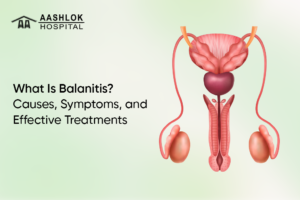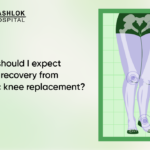What Is Balanitis? Causes, Symptoms, and Effective Treatments

Have you ever experienced unusual annoyance or uneasiness in sensitive areas, making you inquisitive about the origin
of the problem? If so, chances are you suffer from balanitis, a very common infectious disease that occurs on the
penis, foreskin, and glans. The knowledge of balanitis causes and symptoms is the basic foundation for the
prevention of its resultant complex situations and the successful yet harmless treatment. At Aashlok Hospital, we
not only provide expert balanitis treatment but also prioritize personalized care to address your specific needs,
ensuring the best possible outcomes for your health.
What Is Balanitis?
Manifestations of balanitis of the glans penis are inflammation, redness, swelling, and pain. In most cases,
according to studies, among other common problems and infections, this is considered among the main culprits for the
majority of people, especially in uncircumcised men, due to poor hygiene. Moreover, research has indicated that
underlying medical conditions, including poorly controlled diabetes, may exacerbate the condition because of the
increased susceptibility to infections and impaired immune responses.
In fact, a 2007 study published in the Journal of Urology indicated that balanitis is much more common in patients
with diabetes, with up to 40% of such patients experiencing this condition. More importantly, a 2019 systematic
review emphasized the involvement of dermatologic conditions such as eczema and psoriasis in balanitis pathogenesis,
especially in predisposed men. In addition, from the literature, it was also established that circumcision had a
significant impact on decreasing the occurrence of balanitis due to improvement in hygiene and a reduction in
infection risk.
Types of Balanitis
There are many balanitis causes mirroring their different symptoms, which are divided into types for clinical
identification. It is important for you to recognize which type of balanitis you have and its underlying issue. The
most frequent types of balanitis are bacterial, viral, parasitic, or fungal; they are all caused by an infection.
Additionally, there are a few non-infectious kinds, such as:
Zoon’s balanitis
Middle-aged, uncircumcised individuals are susceptible to this chronic (long-lasting) form, which results in an
inflamed, pigmented penis head. Up to 10% of instances of balanitis are caused by it.
Circinate Balanitis
This kind of Balanitis is mapped to reactive arthritis. Reactive arthritis is a form that develops in response to an
infection in the body. In addition to inflammation and discoloration, another sign of circinate balanitis is small
lesions (sores) on the head of the penis.
Pseudoepitheliomatous keratotic and Micaceous balanitis (PKMB)
This extremely uncommon type of balanitis results in scaly warts or pimples on your penis’ head. Individuals over 60
are usually affected by this but it could be treated with appropriate balanitis medication.
Fixed drug eruption
This occurs when specific drugs or chemicals cause a skin lesion to develop on specific skin regions. If you are
unsure of the cause, just search for a balanitis treatment near me and consult the specialist.
Causes of Balanitis
We at Aashlok Hospital use advanced diagnostics to analyze the root cause of your balanitis and curate treatment
plans accordingly. Here, we have put forth the most common underlying issues causing this ailment:
Poor Hygiene Care
Balanitis results from poor hygiene care. In most cases, among males, it occurs since they are not circumcised. The
foreskin usually does not get cleaned properly, and accumulation of smegma, which is a natural secretion, develops.
It causes the formation of a moist environment where skin irritation takes place as well as developing chances for
an infection thus resulting in inflammation of the glans.
Infections
The most common cause of balanitis is infections from being either bacterial, fungal, or viral. Of the causes,
bacterial can be mainly due to bad hygiene in the genital region; however, as a common cause of these fungal
infections, which, by the way, typically are caused by Candida albicans, it is the more common cause in diabetic and
other immunocompromised patients, and the viral infections; such as HSV or HPV, also promote inflammation.
Allergic reactions
Allergic reactions also lead to balanitis. A simple soap, detergent, lotion, and even latex condoms can cause this
irritation. Such chemicals may cause irritation or inflammation of the tender skin that covers the glans and results
in discomfort. Switching to milder, hypoallergenic products usually solves the problem.
Medical Conditions
Most primary causes of balanitis are medical conditions, particularly diabetes. High blood sugar creates a very
conducive environment for infections, especially fungal infections. Also, individuals with weak immune systems have
a higher risk of getting balanitis.
Symptoms of Balanitis
Although balanitis shows diverse symptoms depending on its root cause, there are certain signs that cut across all
and appear in this condition. This condition gradually deteriorates into sores or ulcers, or even blister formation
around the penis if it is not kept under control with appropriate balanitis treatments. Dry cracking of the skin may
be seen if the condition has long been present, or the whole may have a shiny look.
Common physical symptoms
- Redness and Swelling: The glans penis becomes red and inflamed, often accompanied by puffiness
and sometimes pus. - Discomforting and shooting pain: Many individuals experience soreness or tenderness.
- Burning Sensations: These are hallmark symptoms of irritative or infectious balanitis.
- Foul Odor: Bacterial infections may result in a foul-smelling discharge.
Variability of symptoms based on the cause
- Infectious balanitis: There is usually discharge and extremely itchy.
- Irritative balanitis: These will present with burning, soreness, and may be without discharge.
- Chronic balanitis: May present with scarring and inability to retract foreskin due to phimosis.
Effective Treatments for Balanitis
Proper treatment of balanitis is required to eradicate the discomfort and avert the long-term complication. The
approach of the treatment will largely depend on etiology and usually involves measures like improvement in hygiene,
medications, and others with regard to predisposing factors. Aashlok Hospital is one of the best clinics
specializing in complete urological care and providing expert solutions for treating balanitis and related
conditions. If you are looking for “balanitis treatment near me,” Aashlok Hospital has the best care and guidance to
put your health in good hands. Here are some of the most common treatments advised by our urologists.
Medical Treatments
For infectious balanitis, most often, balanitis medications like cream or oral antifungals are prescribed because the
cause is usually candida albicans, a species of yeast. If it has a bacterial cause, that will be treated with some
antibiotics or topical antiseptic creams to eliminate the infection. Allergic or irritant balanitis responds to
topical corticosteroid creams to reduce the inflammation and calm down red, itchy skin.
Surgery
More serious cases of balanitis involve phimosis, or the tightening of the foreskin, and recurrent infections, where
circumcision is advocated as a long-term solution. The procedure removes the foreskin; this reduces the chance of
infection in the future and also ensures better hygiene.
Lifestyle Changes
The best way to prevent the accumulation of smegma is through hygiene; this smegma consists of dead cells, oils, and
moisture that cause infections. Balanitis also requires a daily bath by washing the genital area using warm water
and fragrance-free sensitive soap, especially in an uncircumcised man, as he is at risk of contracting balanitis.
Other preventive measures include avoiding irritants, such as fragrant soap, lotions, or certain fabrics, which would
trigger flare-ups in susceptible individuals. Regulation of blood sugar levels should also be maintained for
diabetic males because too much glucose in the blood favors the growth of fungi.
Home Remedies
Another form of balanitis treatment is warm water baths with Epsom salts or colloidal oatmeal that would slowly
decrease the inflammation and discomfort. Coconut oil or tea tree oil can be applied topically as they are known as
antifungal and anti-inflammatory oils, but they have to be diluted in order not to cause irritation. Aloe vera gel
has healing properties, as well as soothing; this can reduce the pain and redness of balanitis. Some individuals
prefer a slight saltwater soak after having the area cleaned, just in case it would facilitate recovery and avoid
infection.
Conclusion
In conclusion, balanitis requires prompt attention to avoid complications and discomfort. Whether it results from
infections, irritants, or underlying conditions, the right balanitis medication and treatment can provide
considerable relief. We at Aashlok Hospital specialize
in personalized care, offering expert solutions for balanitis. You can trust our expertise with our team of
experienced urologists to guide you toward a comfortable and healthy recovery, resulting in long-term relief from
balanitis.
FAQs
What is the fastest way to cure balanitis?
The best and fastest treatment of balanitis is circumcision; this method removes the warm, moist pouch by removing
the foreskin, allowing for open-air circulation, therefore removing a few cases of the infection that are easily
causative for balanitis. Mild balanitis will heal with good personal hygiene and topical antifungals or topical
antibiotics, these have been proven helpful.
What are the main causes of balanitis?
Balanitis is predominantly caused by poor hygiene, infections (fungal, bacterial, or viral), and irritants like harsh
soaps or allergens.
What is the best medicine for balanitis?
The best medicine for balanitis depends on the cause. Antifungals (e.g., clotrimazole) can be suggested for yeast
infections, mupirocin for bacterial ones, and corticosteroids for inflammatory conditions. Always make a note to
consult an urologist for proper diagnosis and treatment of your condition.
What kills male yeast infection naturally?
Amongst the most preferred solutions for killing male yeast infections are coconut oil or tea tree oil combined with
carrier oil, as they carry antifungal properties.










